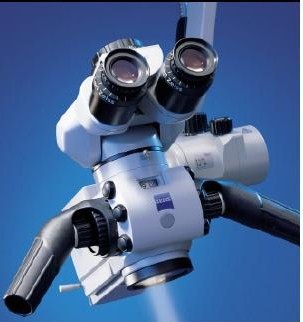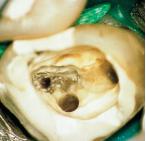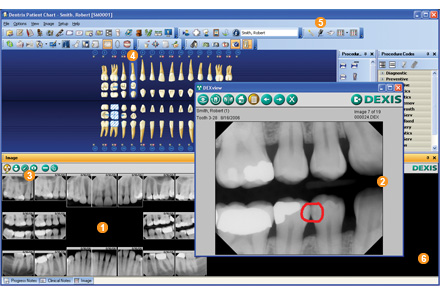What is Root Canal Therapy?
A root canal is one of the most common dental procedures performed, well over 14 million every year. This simple treatment can save your natural teeth and prevent the need of dental implants or bridges.
At the center of your tooth is pulp. Pulp is a collection of blood vessels that helps to build the surrounding tooth. Infection of the pulp can be caused by trauma to the tooth, deep decay, leaking restorations, cracks and chips, or repeated dental procedures. Symptoms of the infection can be identified as visible injury or swelling of the tooth, sensitivity to temperature or pain in the tooth and gums. If you experience any of these symptoms, your dentist will most likely recommend non-surgical treatment to eliminate the diseased pulp.
How is a root canal performed?
The doctor will first completely anesthetize the tooth using a local anesthetic. This injured pulp is painlessly removed and the root canal system is thoroughly cleaned and sealed. This therapy may be completed in one or more visits depending on the treatment required. Success for this type of treatment occurs in about 90% of cases. If your tooth is not amenable to endodontic treatment or the chance of success is unfavorable, you will be informed at the time of consultation or when a complication becomes evident during or after treatment. In addition to local anesthesia, we can provide nitrous oxide or oral sedation if requested. If you are not sedated, you will be able to drive home after your treatment, and you probably will be comfortable returning to your normal routine.
What happens after treatment?
When your root canal therapy has been completed, a record of your treatment will be sent to your restorative dentist. You should contact their office for a follow-up restoration within a few weeks of completion at our office. Your restorative dentist will decide on what type of restoration is necessary to protect your tooth. It is rare for endodontic patients to experience complications after routine endodontic treatment. If a problem does occur, however, we are available at all times to respond. To prevent further decay, the most common cause of the need for root canal therapy, continue to practice good dental hygiene and see your dentist for regular check-ups.
With the appropriate care, your teeth that have had endodontic treatment will last as long as other natural teeth. Yet, a tooth that has received treatment may fail to heal or pain may continue to exist. Sometimes, the pain may occur months or years after treatment. If so, Endodontic Retreatment may be needed.
Endodntic Retreatments
With the appropriate care, your teeth that have had endodontic treatment will last as long as other natural teeth. Yet, a tooth that has received treatment may fail to heal or pain may continue to exist. Sometimes, the pain may occur months or years after treatment. If so, Endodontic Retreatment may be needed.
Improper healing may be caused by:
Ø Curved or narrow canals were not treated during the initial treatment.
Ø Complicated canals went undetected during the initial treatment.
Ø The crown or restoration was not placed within the appropriate amount of time following the procedure.
The crown or restoration did not prevent saliva from contaminating the inside of the tooth.
Ø Curved or narrow canals were not treated during the initial treatment.
Ø Complicated canals went undetected during the initial treatment.
Ø The crown or restoration was not placed within the appropriate amount of time following the procedure.
Ø The crown or restoration did not prevent saliva from contaminating the inside of the tooth.
In some cases, new problems can influence a tooth that was successfully treated:
Ø New decay can expose a root canal filling material, causing infection.
Ø A cracked or loose filling or crown can expose the tooth to new infection.
Once retreatment has been selected as a solution to your problem, the doctors will reopen your tooth to gain access to the root canal filling material. This restorative material will be removed to enable access to the root canal.
The doctors will now clean your canals and carefully examine the inside of the problematic tooth. Once cleaned, the doctors will fill and seal the canals and place a temporary filling in the tooth.
At this point, you will need to return to your dentist as soon as possible in order to have a new crown or restoration placed on the tooth to restore full functionality.
Apicoectomy
Why would I need Endodontic Surgery?
Generally, a root canal is all that is needed to save teeth with injured pulp from extraction. Occasionally, this non-surgical procedure will not be sufficient to heal the tooth and your endodontist will recommend surgery. Endodontic surgery can be used to locate fractures or hidden canals that do not appear on x-rays but still manifest pain in the tooth. Damaged root surfaces or the surrounding bone may also be treated with this procedure. The most common surgery used to save damaged teeth is an apicoectomy or root-end resection.
What is an Apicoectomy?
An incision is made in the gum tissue to expose the bone and surrounding inflamed tissue. The damaged tissue is removed along with the end of the root tip. A root-end filling is placed to prevent reinfection of the root and the gum is sutured. The bone naturally heals around the root over a period of months restoring full function.
Following the procedure, a list of post-operative care instructions will be given to you. There may be some discomfort or swelling for the first 24-48 hours while the incision heals. This is normal for any surgical procedure. To alleviate any discomfort, an appropriate pain medication will be recommended. If you have pain that does not respond to medication, please call our office.
Cracked Teeth
Types of Cracks
Cracked teeth demonstrate many types of symptoms, including pain when chewing, temperature sensitivities, or even the release of biting pressure. It is also common for pain to come and go, making it difficult to diagnose the cause of discomfort.
Chewing can cause movement of the cracked pieces of your tooth, and the pulp within the tooth becomes irritated. At the same time, when biting pressure is released, the crack can close quickly, resulting in sharp pain. Eventually, the pulp will become damaged and tooth will consistently hurt, even when you are not chewing. It is possible that cracks can lead to infection of the pulp tissue, which can spread to the bone and gum surrounding the problematic tooth.
Craze lines
These are tiny cracks that only affect the outer enamel of the tooth. These cracks are more common in adults. These types of cracks are superficial and are usually of no concern.
Fractured Cusp
When a cusp becomes weakened, a fracture may result. The cusp may break off or be removed by a dentist. A fractured cusp rarely damages the pulp, so root canal is not necessary. Your dentist will usually restore the tooth with a full crown.
Cracked Tooth
This type of crack extends from the chewing surface of the tooth and vertically migrates towards the root. In some cases, the crack may extend below the gum line. It is possible for the crack to extend further into the root. Damage to the pulp is commonplace. In this case, root canal treatment is usually necessary. A cracked tooth that is not treated will worsen, resulting in the loss of the tooth. Therefore, early detection is essential.
Split Tooth
A split tooth is usually the result of an untreated cracked tooth. It can be identified by a crack with distinct segments. This type of tooth can never be saved intact. Yet, the position and extent of the problem will dictate whether any portion of the tooth can be saved. Sometimes, endodontic retreatment by the doctors and restoration by your dentist can be used to save a portion of the tooth.
Vertical Root Fracture
A vertical root fracture begins at the root and extends towards the chewing surface of the tooth. Unfortunately, they show minimal symptoms and may go unnoticed. Treatment involves endodontic surgery if a portion of the tooth can be saved by removal of the fractured root. Otherwise the tooth will have to be extracted.
Latest Technologies in endodontic procedures
what new technologies are being used?
We utilize special state-of-the-art surgical operating microscopes for both conventional and microsurgical procedures. Magnification and fiber optic illumination are helpful in aiding the doctor to see the tiny details inside your tooth. This allows for rapid and thorough treatment of even the most complex teeth.
At our office we utilize advanced electronic root-length measuring technology to insure accuracy. These instruments work by measuring and comparing resistance of tooth structure and tooth support tissue to provide a visual and audible signal to indicate precise root length.
Ultrasonics:
All of our treatment rooms are equipped with sophisticated ultrasonic instruments. These units are used to remove obstructions from root canals, aid in the search for extra or calcified canals, and allow for precise root-end fillings in endodontic microsurgery cases. These instruments have also increased the safety of many of our procedures and have aided in the preservation of needed tooth structure.
Nickel Titanium rotary instruments:
A new generation of endodontic instruments have replaced stainless steel. Made from an alloy of nickel and titanium, these new instruments have the unique properties of greater flexibility and greater resistance to fracture as compared to stainless steel. These properties allow the instruments to follow the intricate curves of the root canal, resulting in predictable, efficient and rapid cleaning and shaping of the tooth canals.
Electric Handpieces:
Along with these new nickel-titanium rotary instruments have come the advent of electric motor handpieces. These handpieces are virtually silent, and can decrease the stress and anxiety of treatment.



